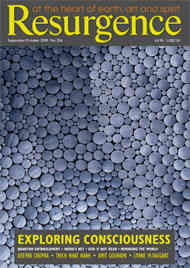Roger Scruton’s book, simply titled Beauty, is a spirited and passionate call for understanding the importance of beauty and to place “this experience in the centre of our lives”. For, he says, “without the conscious pursuit of beauty we risk falling into a world of addictive pleasures and routine desecration, a world in which the worthwhileness of human life is no longer clearly perceivable.”
It would have helped enormously if Scruton had actually started with what he finally says, with clarity, in the last chapter ‘Concluding Thoughts’: “I have not said what beauty is,” as beauty is “not about ‘things in the world’ but about a particular experience of them, and about the pursuit of meaning that springs from that experience”.
Unfortunately, much of the book that precedes this, particularly the early chapters, is rambling and somewhat convoluted. Scruton starts by saying that “we discern beauty in concrete objects and abstract ideas, in works of Nature and works of art, in things, animals and people, in objects, qualities and action…” For him the key to the experience of beauty is an act of rational judgement, and ‘Judging Beauty’ is his very first chapter. In this he suggests that “beauty is a matter of appearance, not of being; and…in exploring beauty we are investigating the sentiments of people, rather than the deep structure of the world”. And, further, that the judgement “focuses on the object judged, not the subject who judges”. Scruton even has a perception of beauty at times being “dangerous”, “corrupting” and “immoral”, and cautions against aiming in every case for beauty, or “supreme beauty”, so as not to end up with “aesthetic overload”, as “the beauty of each…would be at war with the beauty of the rest”.
A key limitation of Scruton’s work is his insistence on approaching the deep subject of beauty so narrowly. He pointedly claims the perch of a philosopher and in a quite reductionist way refuses to be concerned with psychological or evolutionary explanations of the sense (or experience and meaning) of beauty. As a result, rather than bringing a more complete understanding to the beauty experience – why and how it happens – Scruton wades in the rather tired arguments and understanding of Western philosophy, fraught with the old problems of reason versus emotion, the senses and, of course, desire. Much too much emphasis is placed on the idea of “selfless” and “disinterested” contemplation, and there is a rather astonishing distaste for and discomfort with function, utility and desire. Yet his insights into pornography, kitsch and the very morality of beauty are stirring – pointers to the intrinsically relational foundations of beauty and the importance of healthy relationality.
While Scruton rightly stresses that beauty is an experience, he reduces the experience to a rational contemplation. Surely the experience of beauty is an interplay, a dance perhaps, which involves the senses, emotions and thoughts – rational and otherwise? This is something that the Eastern philosophies have, in my opinion, a better and more useful understanding of, with their emphasis on the absence of grasping and holding on – rather than on an absence of desire and functionality.
People can and do experience deep beauty, where there is great joy and bliss, absorption and a sense of integration and wholeness, where they feel momentarily lifted beyond their usual fragmented selves. Deep beauty experiences are imbued with feelings of harmony and balance, and of proportionality and rhythm. I have asked many groups of people, in India and recently in the UK, to describe what they feel in the beauty experience and have found a great commonality across cultures: pleasure, gladness, wellness, delight, joy, spaciousness, connectedness, timelessness, integration and wholeness. (In the Indian view, these experiences of profound and absorbing beauty induce ananda, a deeply meaningful, transformative bliss.)
As an artist, I particularly enjoyed Scruton’s analysis of the predicaments of contemporary art. Yet, despite the occasional attempts to span cultures, with a picture of a Buddha included in the book’s illustrations, it almost seems written primarily for English gentlemen – to be read with suitable philosophic ‘disinterestedness’ over a nice cup of Ceylon tea. Scruton’s passion for the art he adores is palpable, and he gives many examples from Western music, literature, art and architecture. But it must be said that what may ‘look right’ to him, and to others within his cultural context, may not, to me, from a different cultural tradition. It may not evoke the beauty experience for me.
It is not in the art objects that there is commonality across cultures, but in their aesthetic understandings and in the experience itself. When Scruton explicates “expression” in art via emotion and intuition, I find strong resonances with the classical Indian aesthetical concepts of rasa and dhvani. Though it must be said that while for Scruton, expression is about individualism and uniqueness, the drift in the Indian imagination is in the opposite direction – towards glimpses of the universal and the undifferentiated ground of all reality.
This book brings much-needed attention to the subject of beauty. It should form part of a new dialogue that broadens and deepens this search – and please let’s make it less anthropocentric, and move beyond the “rational soul” construct, and consider the intelligence of Nature. We need to understand that there may be very good reasons why complex systems – humans, cells, Nature and climate – are imbued with beauty, and that there is a deeper beauty, beyond appearances, that might, as Scruton suggests, embody its self in matter and form.
What is needed is a new and more integrated understanding of beauty, that builds upon the growing understanding in many disciplines about all things being fundamentally relational. We need to know whether beauty is the harmony and rhythm, the joy and wellness of all relational goodness. Scruton does say “beauty is…firmly rooted in the scheme of things as goodness”. We sorely need more of this beauty, in art, in everyday life, and in all our social systems.






